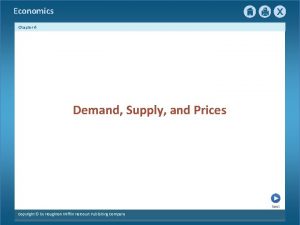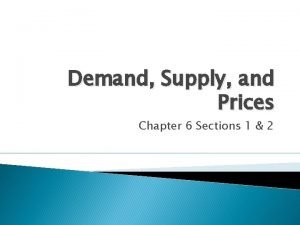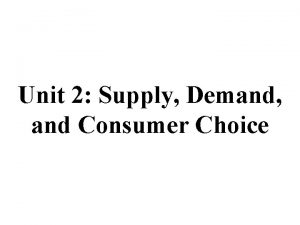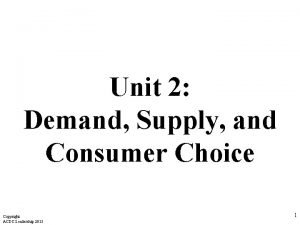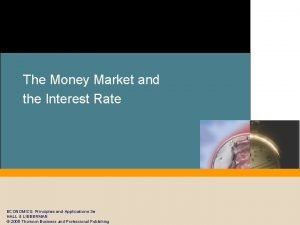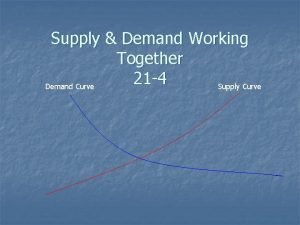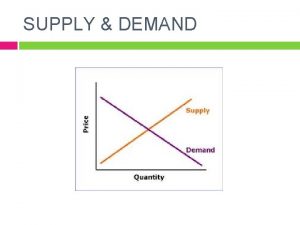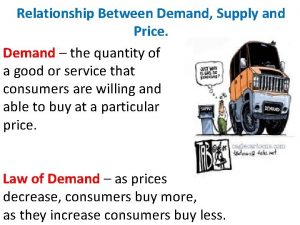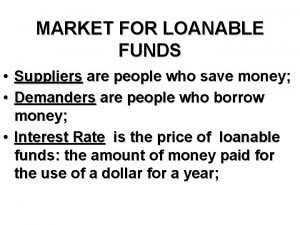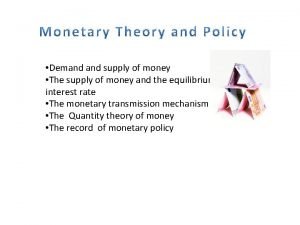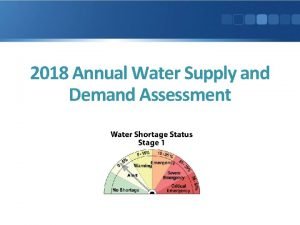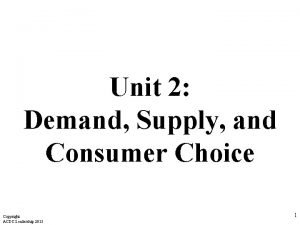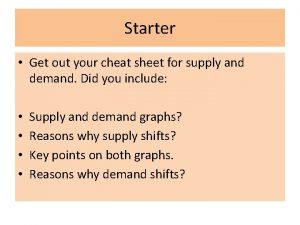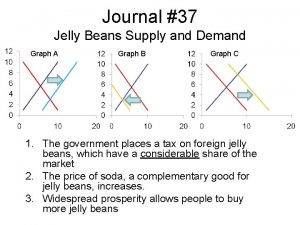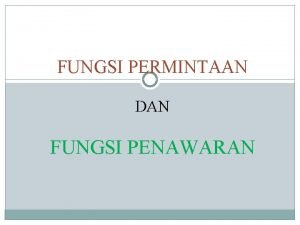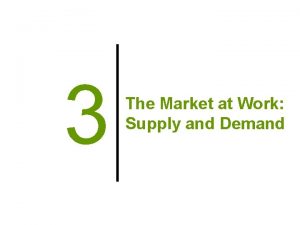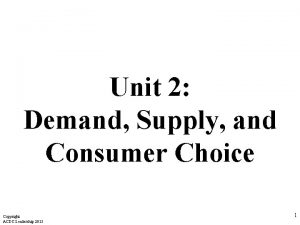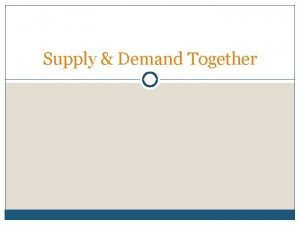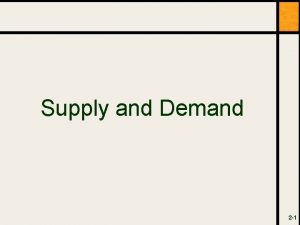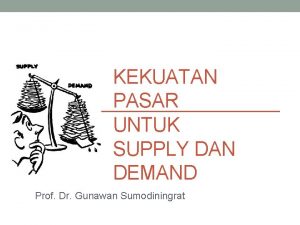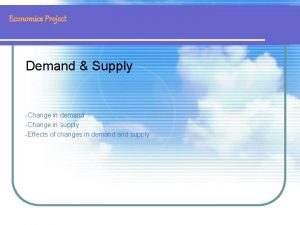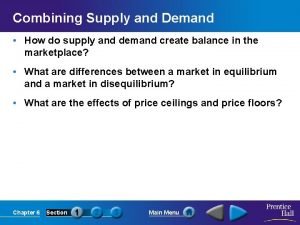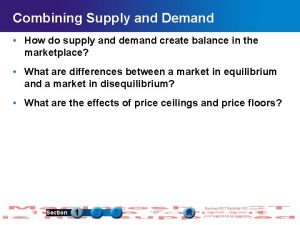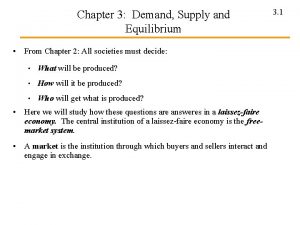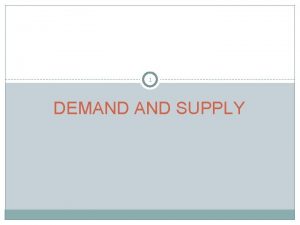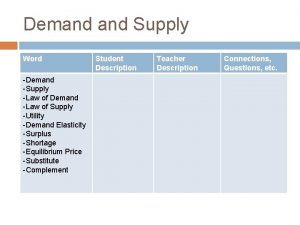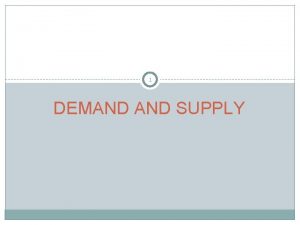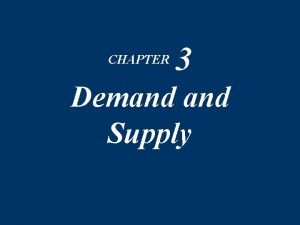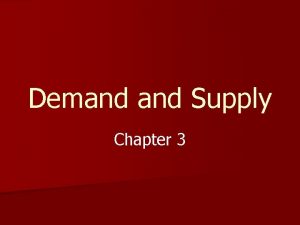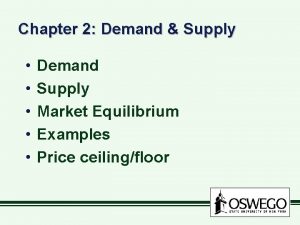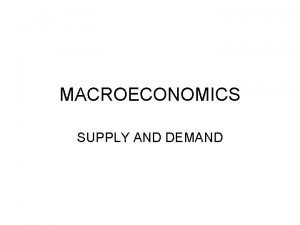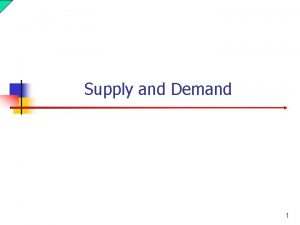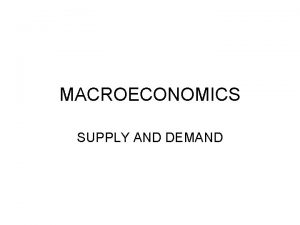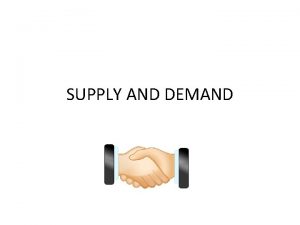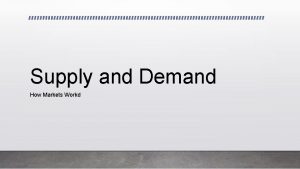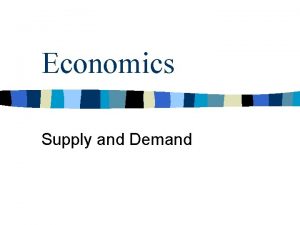CHAPTER 3 Supply and Demand Supply and Demand


















































- Slides: 50

CHAPTER 3 Supply and Demand

Supply and Demand ØCompetitive market – Example: ticket scalpers and their customers. ØA market in which there are many buyers and sellers of the same good or service. ØNo individual’s action have a noticeable effect on the price at which the good or service is sold. ØThe behavior of a competitive market is well described by a model known as the supply and demand model. 2

Supply and Demand ØThe supply and demand model - 5 key elements: ØThe demand curve ØThe supply curve ØFactors that cause the demand curve to shift, and factors that cause the supply curve to shift ØThe equilibrium price ØHow the equilibrium price changes when the supply and demand curves shift 3

The Demand Schedule and the Demand Curve Demand schedule – shows how much of a good or service consumers will want to buy at different prices Demand curve – a graphical representation of the demand schedule The law of demand – a higher price for a good, other things equal, leads people to demand a smaller quantity of the good. 4

An Increase in Demand Announcement of Gretzky’s retirement generates an increase in demand – a rise in the quantity demanded at any given price – the demand curve shifts to the right 5

Movement Along the Demand Curve vs. Shift of the Demand Curve A movement along the demand curve is the change in the quantity demanded for a good as a result of a change in that good’s price. 6

Shifts of the Demand Curve 7

What causes a demand curve to shift? Ø Changes in the Prices of Related Goods Ø Changes in Income Ø Changes in Tastes Ø Changes in Expectations 8

What causes a demand curve to shift? Ø Changes in the Prices of Related Goods Ø Ø Substitutes – a fall in the price of one good leads to a fall in demand for the other good (music concert & hockey games) Complements – a fall in the price of one good leads to an increase in demand for the other good (parking & sports tickets) 9

What causes a demand curve to shift? Ø Changes in the Prices of Related Goods Ø Ø Ø Substitutes – a fall in the price of one good leads to a fall in demand for the other good (music concert & hockey games) Complements – a fall in the price of one good leads to an increase in demand for the other good (parking & sports tickets) Changes in Income Ø Normal Goods – demand for a good increases when consumer income rises Ø Inferior Goods – demand for a good decreases when income rises. Example: public transportation. 10

What causes a demand curve to shift? Ø Changes in the Prices of Related Goods Ø Ø Ø Substitutes – a fall in the price of one good leads to a fall in demand for the other good (music concert & hockey games) Complements – a fall in the price of one good leads to an increase in demand for the other good (parking & sports tickets) Changes in Income Ø Normal Goods – demand for a good increases when consumer income rises Ø Inferior Goods – demand for a good decreases when income rises. Example: public transportation Ø Changes in Tastes Ø When tastes change in favor of (against a) good, more (fewer) people want to buy it at any given price, the demand curve shifts to the right (left). 11

What causes a demand curve to shift? Ø Changes in the Prices of Related Goods Ø Ø Ø Substitutes – a fall in the price of one good leads to a fall in demand for the other good (music concert & hockey games) Complements – a fall in the price of one good leads to an increase in demand for the other good (parking & sports tickets) Changes in Income Ø Normal Goods – demand for a good increases when consumer income rises Ø Inferior Goods – demand for a good decreases when income rises Ø Changes in Tastes Ø Ø When tastes change in favor of (against a) good, more (fewer) people want to buy it at any given price, the demand curve shifts to the right (left). Changes in Expectations – expectations of a future rise (decline) in price leads to an increase (decrease) in demand today 12

The Supply Curve Supply schedule – shows how much of a good or service would be supplied at different prices Supply curve – a graphical representation of the supply schedule. The higher the price being offered, the more hockey tickets people will be willing to part with – the more of any good they will be willing to sell. 13

Shifts of the supply curve: a decrease in supply Announcement of Gretzky’s retirement generates a decrease in supply – a decrease in the quantity supplied at any given price. The supply curve shifts to the left. Why? Because ticket holders expect the price of tickets to increase and as a result they would rather wait to sell their tickets to 14 scalpers.

Movement Along the Supply Curve vs. Shift of the Supply Curve A movement along the supply curve is the change in the quantity supplied of a good as a result of a change in that good’s price. 15

Shifts of the Supply Curve 16

What causes a supply curve to shift? Ø Ø Ø Changes in Input Prices Changes in Technology Changes in Expectations 17

What causes a supply curve to shift? Ø Changes in Input Prices Ø An input is a good that is used to produce another good. A fall in input prices leads to a shift to the right of the supply curve. 18

What causes a supply curve to shift? Ø Changes in Input Prices Ø An input is a good that is used to produce another good. A fall in input prices leads to a shift to the right of the supply curve. Ø Changes in Technology – better technology leads to a shift to the right of the supply curve. 19

What causes a supply curve to shift? Ø Changes in Input Prices Ø An input is a good that is used to produce another good. A fall in input prices leads to a shift to the right of the supply curve. Ø Changes in Technology – better technology leads to a shift to the right of the supply curve. Ø Changes in Expectations – an expectation that the price of a good will increase in the future causes supply to decrease (shift to the left) today. An expectation that the price of a good will decrease in the future causes supply to increase (shift to the right) today. 20

Market Equilibrium A competitive market is in equilibrium when the price has moved to a level at which the quantity demanded equals the quantity supplied for a particular good. 21

Price Above Its Equilibrium Level Creates a Surplus A price above its equilibrium creates a surplus. A Surplus will lead to a fall in the market price towards the equilibrium market price. Why? Because producers will have an incentive to lower prices to be able to sell their supply, and buyers will offer lower prices for the products. 22

Price Below Its Equilibrium Level Creates a Shortage A price below its equilibrium creates a shortage. A Shortage will lead to a rise in the market price towards the equilibrium market price. Because producers will have an incentive to increase prices due to the large demand for their goods, and buyers will higher prices for the products 23 they want to consume.

Equilibrium and Shifts of the Demand Curve An increase in the price of tea leads to an increase in the demand for coffee (substitute goods). A new equilibrium level of price and quantity is reached. When demand for a good increases, the equilibrium price and the equilibrium quantity of the good both rise. 24

Equilibrium and Shifts of the Supply Curve After a technological change increases the supply of silicon chips, the supply curve shifts to the right. A new equilibrium level of price and quantity is reached. When supply of good falls, the equilibrium price increases and the equilibrium quantity of the good fall. 25

Simultaneous Shifts of the Demand Supply Curves Ø When demand supply change in the same direction ( for example both increase), there is a predictable change in quantity (quantity increases) but the change in price is ambiguous and depends on how much each curve shifts relative to the other one. Ø When demand supply change in the opposite direction (for example supply increases and demand falls), there is a predictable change in price (in this case price falls) and the change in quantity is ambiguous and depends on how much each curve shifts relative to the other one. 26

Simultaneous Shifts of the Demand Supply Curves When demand increases and supply decreases, the price rises but the change in the quantity is ambiguous. (not shown) When demand decreases and supply increases, the price falls but the change in quantity is ambiguous. 27

Review exercises from textbook (end of chapter problems) 28

Review exercises 29

Review exercises 30

Review exercises 31

Review exercises 32

Review exercises 33

Review exercises 34

Review exercises 35

Review exercises 36

Review exercises 37

Review exercises 38

Review exercises 39

Review exercises 40

Review exercises 41

Review exercises 42

Review exercises 43

Review exercises 44

Review exercises 45

Review exercises 46

Review exercises 10 47

Review exercises 10 48

Review exercises 49

Review exercises 50
 Module 5 supply and demand introduction and demand
Module 5 supply and demand introduction and demand Matching supply with demand
Matching supply with demand Shifters of supply
Shifters of supply Chapter 6 section 1 price supply and demand together
Chapter 6 section 1 price supply and demand together Shift in sras curve
Shift in sras curve Chapter 6 demand supply and prices
Chapter 6 demand supply and prices Chapter 6 supply demand and government policies
Chapter 6 supply demand and government policies Chapter 5 section 1 supply and the law of supply
Chapter 5 section 1 supply and the law of supply Measures to correct excess and deficient demand
Measures to correct excess and deficient demand Independent demand vs dependent demand
Independent demand vs dependent demand Halimbawa ng demand schedule
Halimbawa ng demand schedule What is demand estimation in managerial economics
What is demand estimation in managerial economics Paradox of value
Paradox of value Independent demand and dependent demand
Independent demand and dependent demand Unit 2 demand supply and consumer choice
Unit 2 demand supply and consumer choice Unit 2 demand supply and consumer choice
Unit 2 demand supply and consumer choice Money market supply and demand
Money market supply and demand Combining supply and demand worksheet
Combining supply and demand worksheet Interaction of demand and supply
Interaction of demand and supply What is the relationship between supply and price
What is the relationship between supply and price Who are the demanders of loanable funds
Who are the demanders of loanable funds Equalibrium
Equalibrium Supply and demand economics project
Supply and demand economics project Money supply curve
Money supply curve Rule of supply and demand
Rule of supply and demand Aggregate supply shifters
Aggregate supply shifters Aggregate supply and demand graph
Aggregate supply and demand graph Annual water supply and demand assessment
Annual water supply and demand assessment How to calculate aggregate demand
How to calculate aggregate demand Unit 2 demand supply and consumer choice
Unit 2 demand supply and consumer choice Supply and demand together
Supply and demand together Supply and demand cheat sheet
Supply and demand cheat sheet Supply function formula
Supply function formula Jelly beans supply and demand
Jelly beans supply and demand Fungsi demand
Fungsi demand Supply and demand conclusion
Supply and demand conclusion Supply and demand
Supply and demand Unit 2 demand supply and consumer choice answer key
Unit 2 demand supply and consumer choice answer key Supply and demand activities
Supply and demand activities Indiana jones supply and demand
Indiana jones supply and demand Supply and demand together
Supply and demand together Tipse economics
Tipse economics Supply and demand drawing
Supply and demand drawing Matching demand and supply
Matching demand and supply Supply and demand together
Supply and demand together Supply and demand economics project
Supply and demand economics project Demand and supply analysis
Demand and supply analysis Combining supply and demand answer key
Combining supply and demand answer key Section 1 combining supply and demand
Section 1 combining supply and demand Supply demand equilibrium
Supply demand equilibrium Supply and demand board game
Supply and demand board game



